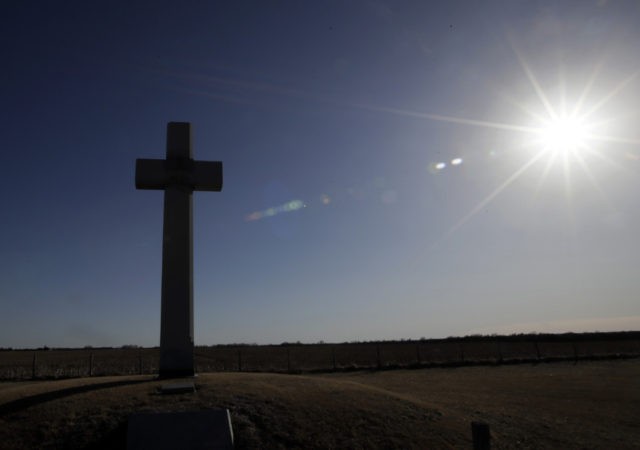The fate of a 40-foot high cross erected in 1925 to honor men who died in World War I will be the focus of arguments before the Supreme Court Wednesday.
The concrete cross, known as the Peace Cross, was erected in Bladensburg, Maryland by the American Legion. It has been owned by the Maryland National Capital Park and Planning Commission since 1961.
Atheists demanded the federal courts rule the monument violated the constitutional prohibition on the establishment of religion, claiming they were offended by the display. The cross sits at a prominent intersection in the Washington area. The Fourth Circuit Court of Appeals, in a two to one decision, ordered that the cross be removed or altered to remove any religious symbolism.
The American Legion and the Maryland park commission are appealing that decision, with President Donald Trump’s administration joining them.
The Supreme Court has struggled for decades to lay out clear rules for public displays of religious symbols and activities. Supporters of the Maryland monument are now asking the court to throw out the complex web of rules created by often conflicting precedents in favor of a simpler test of whether an act of government coerces religious belief.
“History shows that the Framers understood the Establishment Clause as prohibiting the coercion of religious belief or adherence, but not the acknowledgment of religion in public life,” Deputy Solicitor General Jeffrey Wall wrote in a brief on behalf of the U.S. government.
The confusion over what the constitution permits dates at least back to the Supreme Court’s 1971 decision Lemon v. Kurtzman, which saw the Supreme Court strike down Pennsylvania and Rhode Island laws that provided salaries to teachers of secular subjects in private religious schools. In that case, decided eight to one, the court annunciated what has become known as the Lemon Test, a three-pronged inquiry that asks whether the government action was undertaken with a religious intention, whether the primary effect is to advance or inhibit religion, and whether the action excessively entangles the government in religion.
Any hopes that the Lemon test would provide clear guidance for future Establish Clause cases turned sour when the court appeared to abandon it in 1983’s Marsh v. Chambers. In that case, the court upheld Nebraska’s practice of having an official chaplain begin each session of the state legislature with a prayer. Chief Justice Warren Burger rested the Court’s opinion on historical custom, pointing out that the same Congress that approved the First Amendment also established chaplains for the House and Senate.
The Lemon test was muddled by rulings in the 1980s in which Justice Sandra Day O’Connor said the central question was whether or not a government action amounted to an “endorsement” of religion. In County of Allegheny v. American Civil Liberties Union, a divided court held that a crèche with the words “Gloria in Excelsis Deo” displayed inside a county courthouse violated the Establishment Clause of the First Amendment while a Menorah-Christmas tree display outside the city-county building did not. The latter was merely a “recognition” of the two holidays, rather than an “endorsement” of them. Three conservatives on the court objected that the “endorsement” test was wrong and that the court should simply look for signs of religious coercion.
In later cases barring prayers at public school graduation ceremonies and even student-led prayers before football games, Justice Anthony Kennedy added a further twist. Although Kennedy had joined the conservative dissenters in Allegheny, in the school cases he authored opinions for the court that appeared to support O’Connor’s endorsement test on the grounds that young people were so vulnerable to peer pressure that an endorsement amounted to coercion.
And then there were the Ten Commandments cases. In 2005, a 5-4 divided Supreme Court ruled in Van Orden v. Perry that a decades-old display of the Ten Commandments on the grounds of the state capitol in Texas was constitutional because it was a “passive” monument to the role of “both religion and government” in Texas’s history. But on the same day, in McCreary v. ACLU, the court struck down a more recently erected display of the Ten Commandments in Kentucky. Justice Stephen Breyer, who voted in favor of Texas and against Kentucky, created yet another test that amounted to nothing more than “I know an Establishment Clause violation when I see it.”
Supporters of the Maryland monument hope that the Supreme Court will take notice of the mess its contradictory decisions have created and adopt the clearer standard barring coercion. The case will illustrate how far the Court’s Republican-appointed majority will go in overturning precedent that prompted conservatives to dissent in earlier cases. Chief Justice John Roberts has shown a strong preference for sticking by precedents, even when earlier conservative Justices had argued they were wrongly decided. And it is not clear where the Court’s newest Justice, Brett Kavanaugh, stands with regard to the court’s liberal precedents.
The court could also take a narrower view of the case, perhaps by ruling that the monument is constitutionally acceptable under the Van Orden precedent.
The cases are American Legion v. American Humanist Association, 17-1717, and Maryland-National Capital Park and Planning Commission v. American Humanist Association, 18-18.

COMMENTS
Please let us know if you're having issues with commenting.